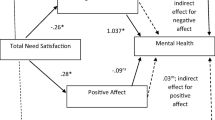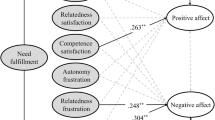Abstract
Psychological need constructs have received increased attention within self-determination theory research. Unfortunately, the most widely used need-satisfaction measure, the Basic Psychological Needs Scale (BPNS; Gagné in Motiv Emot 27:199–223, 2003), has been found to be problematic (Johnston and Finney in Contemp Educ Psychol 35:280–296, 2010). In the current study, we formally describe an alternate measure, the Balanced Measure of Psychological Needs (BMPN). We explore the factor structure of student responses to both the BPNS and the BMPN, followed by an empirical comparison of the BPNS to the BMPN as predictors of relevant outcomes. For both scales, we tested a model specifying three latent need factors (autonomy, competence, and relatedness) and two latent method factors (satisfaction and dissatisfaction). By specifying and comparing a series of nested confirmatory factor analytic models, we examine the theoretical structure of the need satisfaction variables and produce evidence for convergent and discriminant validity of the posited constructs. The results of our examination suggest that the three need variables should not be combined into one general need factor and may have separate satisfaction and dissatisfaction dimensions. Our model comparisons also suggest the BMPN may be an improved instrument for SDT researchers.

Similar content being viewed by others
Explore related subjects
Discover the latest articles and news from researchers in related subjects, suggested using machine learning.References
Baard, P. P., Deci, E. L., & Ryan, R. M. (2004). Intrinsic need satisfaction: A motivational basis of performance and well-being in two work settings. Journal of Applied Social Psychology, 34, 2045–2068.
Bartholomew, K. J., Ntoumanis, N., Ryan, R. M., Bosch, J. A., & Thogerson-Ntoumani, C. (2011). Self-determination theory and diminished functioning: The role of interpersonal control and psychological need thwarting. Personality and Social Psychology Bulletin, 37(11), 1459–1473.
Byrne, B. M. (2006). Structural equation modeling with EQS: Basic concepts, applications, and programming (2nd ed.). Mahwah, NJ: Erlbaum Associates Publishers.
Campbell, D. T., & Fiske, D. W. (1959). Convergent and discriminant validation by the multi-trait-multi-method matrix. Psychological Bulletin, 56, 81–105.
Cheung, G. W., & Rensvold, R. B. (2002). Evaluating goodness-of-fit indexes for testing measurement invariance. Structural Equation Modeling, 9, 233–255.
Costa, P. T., Jr, & McCrae, R. R. (1985). The NEO personality inventory manual. Odessa, FL: Psychological Assessment Resources.
Deci, E. L., & Ryan, R. M. (1985). Intrinsic motivation and self-determination in human behavior. New York, NY: Plenum.
Deci, E. L., & Ryan, R. M. (1991). A motivational approach to self: Integration in personality. In R. Dienstbier (Ed.), Nebraska symposium on motivation. Perspectives on motivation (Vol. 38, pp. 237–288). Lincoln, NE: University of Nebraska Press.
Deci, E. L., & Ryan, R. M. (2000). The “what” and “why” of goal pursuits: Human needs and the self-determination of behavior. Psychological Inquiry, 11, 227–268.
Deci, E. L., Ryan, R. M., Gagné, M., Leone, D. R., Usunov, J., & Kornazheva, B. P. (2001). Need satisfaction, motivation, and well-being in the work organizations of a former eastern bloc country. Personality and Social Psychology Bulletin, 27, 930–942.
DeVellis, R. F. (2003). Scale development: Theory and applications. Thousand Oaks, CA: Sage Publications.
Diener, E. (1994). Assessing subjective well-being: Progress and opportunities. Social Indicators Research, 31, 103–157.
Diener, E., Emmons, R., Larsen, R., & Griffin, S. (1985). The satisfaction with life scale. Journal of Personality Assessment, 47, 1105–1117.
Filak, V., & Sheldon, K. M. (2003). Student psychological need-satisfaction and college teacher-course evaluations. Educational Psychology, 23, 235–247.
Gagne, M. (2003). The role of autonomy support and autonomy orientation in prosocial behavior engagement. Motivation and Emotion, 27, 199–223.
Hu, L., & Bentler, P. M. (1999). Cutoff criteria for fit indexes in covariance structure analysis: Conventional criteria versus new alternatives. Structural Equation Modeling, 6, 1–55.
Johnston, M. M., & Finney, S. J. (2010). Measuring basic needs satisfaction: evaluating previous research and conducting new psychometric evaluations of the basic needs satisfaction in general scale. Contemporary Educational Psychology, 35, 280–296.
Kashdan, T. B., Julian, T., Merritt, K., & Uswatte, G. (2006). Social anxiety and posttraumatic stress in combat veterans relations to well-being and character strengths. Behaviour Research and Therapy, 44, 561–583.
Kline, R. B. (2005). Principles and practice of structural equation modeling (2nd ed.). New York, NY: Guilford Press.
La Guardia, J. G., Ryan, R. M., Couchman, C. E., & Deci, E. L. (2000). Within-person variation in security of attachment: A self-determination theory perspective on attachment, need fulfillment, and well-being. Journal of Personality and Social Psychology, 79, 367–384.
Marsh, H. W., Byrne, B. M., & Craven, R. (1992). Overcoming problems in confirmatory factor analyses of MTMM data: The correlated uniqueness model and factorial invariance. Multivariate Behavioral Research, 27, 489–507.
Marsh, H. W., Hau, K., & Wen, K. (2004). In search of the golden rules: Comment on hypothesis-testing approaches to setting cutoff values for fit indexes and dangers in overgeneralizing Hu and Bentler’s (1999) findings. Structural Equation Modeling, 11, 320–341.
McAdams, D. P. (1980). A thematic coding system for the intimacy motive. Journal of Research in Personality, 14, 413–432.
Meyer, B., Enstrom, M. K., Harstveit, M., Bowles, D. P., & Beevers, C. G. (2007). Happiness and despair on the catwalk: Need satisfaction, well-being, and personality adjustment among fashion models. The Journal of Positive Psychology, 2, 2–17.
Niemiec, C. P., Ryan, R. M., & Deci, E. L. (2009). The path taken: Consequences of attaining intrinsic and extrinsic aspirations in post-college life. Journal of Research in Personality, 43, 291–306.
Reeve, J., & Sickenius, V. (1994). Development and validation of a brief measure of the three psychological needs underlying intrinsic motivation: The AFS scales. Educational and Psychological Measurement, 54, 506–515.
Reis, H. T., Sheldon, K. M., Gable, S. L., Roscoe, J., & Ryan, R. M. (2000). Daily well-being: The role of autonomy, competence, and relatedness. Personality and Social Psychology Bulletin, 26, 419–435.
Ryan, R. M. (1995). Psychological needs and the facilitation of integrative processes. Journal of Personality, 63, 397–427.
Ryan, R. M., & Deci, E. L. (2008). Self-determination theory and the role of basic psychological needs in personality and the organization of behavior. In O. John, R. Roberts, & L. A. Pervin (Eds.), Handbook of personality: Theory and research (pp. 654–678). New York, NY: Guilford.
Sheldon, K. M. (2004). Optimal human being: An integrated multi-level perspective. Trenton, NJ: Erlbaum.
Sheldon, K. M., Abad, N., & Hinsch, C. (2011a). A two process view of Facebook use and relatedness need-satisfaction: Disconnectedness drives use and connectedness rewards it. Journal of Personality and Social Psychology, 100, 766–775.
Sheldon, K. M., & Bettencourt, B. A. (2002). Psychological needs and subjective well-being in social groups. British Journal of Social Psychology, 41, 25–38.
Sheldon, K. M., Cheng, C., & Hilpert, J. (2011b). Understanding well-being and optimal functioning: Applying the multilevel personality in context (MPIC) model. Psychological Inquiry, 22, 1–16.
Sheldon, K. M., & Elliot, A. J. (1999). Goal striving, need-satisfaction, and longitudinal well-being: The self-concordance model. Journal of Personality and Social Psychology, 76, 482–497.
Sheldon, K. M., Elliot, A. J., Kim, Y., & Kasser, T. (2001). What’s satisfying about satisfying events? Comparing ten candidate psychological needs. Journal of Personality and Social Psychology, 80, 325–339.
Sheldon, K. M., & Gunz, A. (2009). Psychological needs as basic motives, not just experiential requirements. Journal of Personality, 77, 1467–1492.
Sheldon, K. M., Ryan, R. M., & Reis, H. T. (1996). What makes for a good day? Competence and autonomy in the day and in the person. Personality and Social Psychology Bulletin, 22, 1270–1279.
Sheldon, K. M., & Schuler, J. (2011). Needing, wanting, and having: Integrating motive disposition theory and self-determination theory. Journal of Personality and Social Psychology, 101, 1106–1123.
Smith, C. V. (2007). In pursuit of ‘good’ sex: Self-determination and the sexual experience. Journal of Social and Personal Relationships, 24, 69–85.
Van den Broeck, A., Vansteenkiste, M., De Witte, H., Soenens, B., & Lens, W. (2010). Capturing autonomy, competence, and relatedness at work: Construction and initial validation of the work-related basic need satisfaction scale. Journal of Occupational and Organizational Psychology, 83, 981–1002.
Vlachopoulos, S. P., & Michailidou, S. (2006). Development and initial validation of a measure of autonomy, competence, and relatedness in exercise: The basic psychological needs in exercise scale. Measurement in Physical Education and Exercise Science, 103, 179–201.
Watson, D., Tellegen, A., & Clark, L. (1988). Development and validation of brief measures of positive and negative affect: The PANAS scales. Journal of Personality and Social Psychology, 54, 1063–1070.
Wilson, P. M., Rogers, W. T., Rodgers, W. M., & Wild, T. C. (2006). The psychological need satisfaction in exercise scale. Exercise Psychology, 28, 231–351.
Author information
Authors and Affiliations
Corresponding author
Appendix: The BMPN
Appendix: The BMPN
Relatedness
-
1.
I felt a sense of contact with people who care for me, and whom I care for.
-
2.
I was lonely.
-
3.
I felt close and connected with other people who are important to me.
-
4.
I felt unappreciated by one or more important people.
-
5.
I felt a strong sense of intimacy with the people I spent time with.
-
6.
I had disagreements or conflicts with people I usually get along with.
Competence
-
7.
I was successfully completing difficult tasks and projects.
-
8.
I experienced some kind of failure, or was unable to do well at something.
-
9.
I took on and mastered hard challenges.
-
10.
I did something stupid, that made me feel incompetent.
-
11.
I did well even at the hard things.
-
12.
I struggled doing something I should be good at.
Autonomy
-
13.
13. I was free to do things my own way.
-
14.
14. I had a lot of pressures I could do without.
-
15.
15. My choices expressed my “true self.”
-
16.
16. There were people telling me what I had to do.
-
17.
17. I was really doing what interests me.
-
18.
18. I had to do things against my will.
Administration
Items should be alternated from the three subscales. Participants might rate their lives in general, their experience during some recent period of time, or their experience within some particular context or setting. Item wording may be modified slightly to fit (items above pertain to participants’ recent experiences).
Scoring
Satisfaction (odd items) and Satisfaction (even items) scores should be computed for each need (6 subscale scores in all). These may be examined separately, or, three aggregate need satisfaction scores can be computed by subtracting the dissatisfaction score for a particular need from the satisfaction score for that need.
Rights and permissions
About this article
Cite this article
Sheldon, K.M., Hilpert, J.C. The balanced measure of psychological needs (BMPN) scale: An alternative domain general measure of need satisfaction. Motiv Emot 36, 439–451 (2012). https://doi.org/10.1007/s11031-012-9279-4
Published:
Issue Date:
DOI: https://doi.org/10.1007/s11031-012-9279-4




